Hotpoint ECOSF 109 User Manual

Instructions for use
WASHING MACHINE
|
|
|
|
|
|
|
|
|
|
|
|
|
|
|
|
Contents |
|
||
|
|
|
|
|
|
GB |
|||
|
|
|
|
|
|
|
|
||
|
|
|
|
|
|
Installation, 2-3 |
|
||
GB |
|
CZ |
|
SK |
|
|
|||
|
|
|
Unpacking and levelling |
||||||
|
|
|
|
|
|
Connecting the electricity and water supplies |
|||
English,1 |
Èeský,13 |
Slovensky,25 |
|||||||
The first wash cycle |
|||||||||
|
|
|
|
|
|
Technical data |
|||
GR RO
ЕЛЛЗНЙКБ,37 Romвnг,49
Description of the washing machine and starting a wash cycle, 4-5
Control panel Indicator lights Starting a wash cycle
ECOSF 109
Wash cycles, 6
Table of wash cycles
Personalisation, 7
Setting the temperature
Setting the spin speed
Functions
Detergents and laundry, 8
Detergent dispenser drawer Bleach cycle
Preparing the laundry Garments requiring special care Load balancing system
Precautions and tips, 9
General safety Disposal
Opening the porthole door manually
Care and maintenance, 10
Cutting off the water or electricity supply Cleaning the washing machine
Cleaning the detergent dispenser drawer Caring for the door and drum of your appliance Cleaning the pump
Checking the water inlet hose
Troubleshooting, 11
Service, 12
1
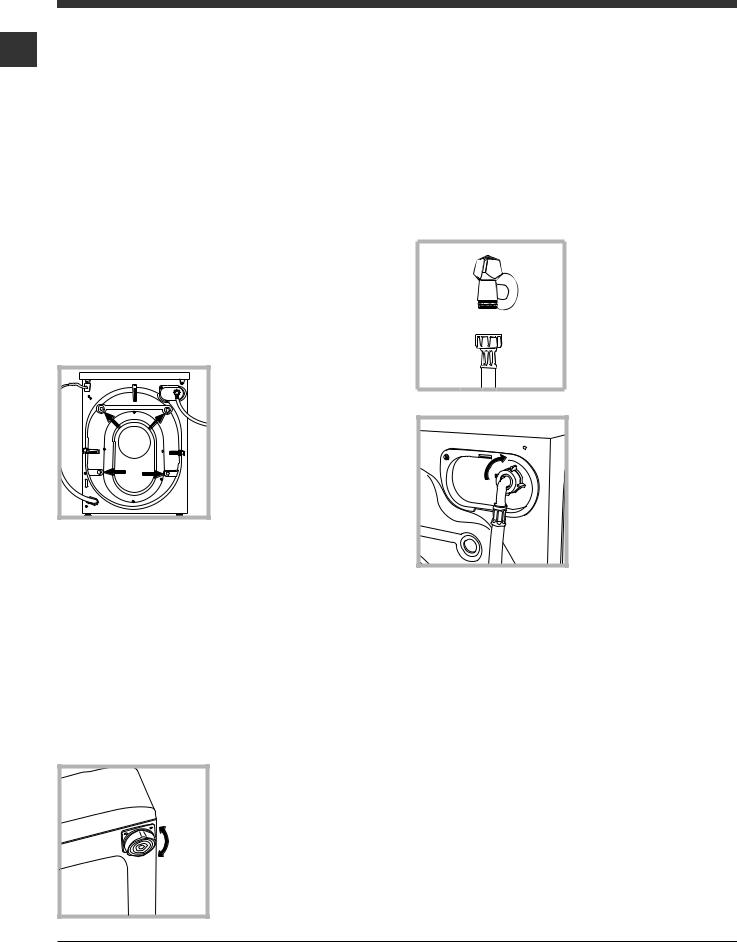
Installation
This instruction manual should be kept in a safe GB place for future reference. If the washing machine is
sold, transferred or moved, make sure that the instruction manual remains with the machine so that the new owner is able to familiarise himself/herself with its operation and features.
Read these instructions carefully: they contain vital information relating to the safe installation and operation of the appliance.
Unpacking and levelling
Unpacking
1.Remove the washing machine from its packaging.
2.Make sure that the washing machine has not been damaged during the transportation process. If it has been damaged, contact the retailer and do not proceed any further with the installation process.
3. Remove the 4 protective screws (used during transportation) and the rubber washer with the corresponding spacer, located on the rear part of the appliance (see figure).
4.Close off the holes using the plastic plugs provided.
5.Keep all the parts in a safe place: you will need them again if the washing machine needs to be moved to another location.
Packaging materials should not be used as toys for children.
Levelling
1. Install the washing machine on a flat sturdy floor, without resting it up against walls, furniture cabinets or anything else.
2. If the floor is not perfectly level, compensate for any unevenness by tightening or loosening the adjustable front feet (see figure); the angle of inclination, measured in relation to the worktop, must not exceed 2°.
Levelling the machine correctly will provide it with stability, help to avoid vibrations and excessive noise and prevent it from shifting while it is operating. If it is placed on carpet or a rug, adjust the feet in such a way as to allow a sufficient ventilation space underneath the washing machine.
Connecting the electricity and water supplies
Connecting the water inlet hose
1. Connect the supply pipe by screwing it to a cold water tab using a ¾ gas threaded connection (see figure).
Before performing the connection, allow the water to run freely until it is perfectly clear.
2. Connect the inlet hose to the washing machine by screwing it onto the corresponding water inlet of the appliance, which is situated on the top righthand side of the rear part of the appliance (see figure).
3. Make sure that the hose is not folded over or bent.
The water pressure at the tap must fall within the values indicated in the Technical details table (see next page).
If the inlet hose is not long enough, contact a specialised shop or an authorised technician.
Never use second-hand hoses.
Use the ones supplied with the machine.
2
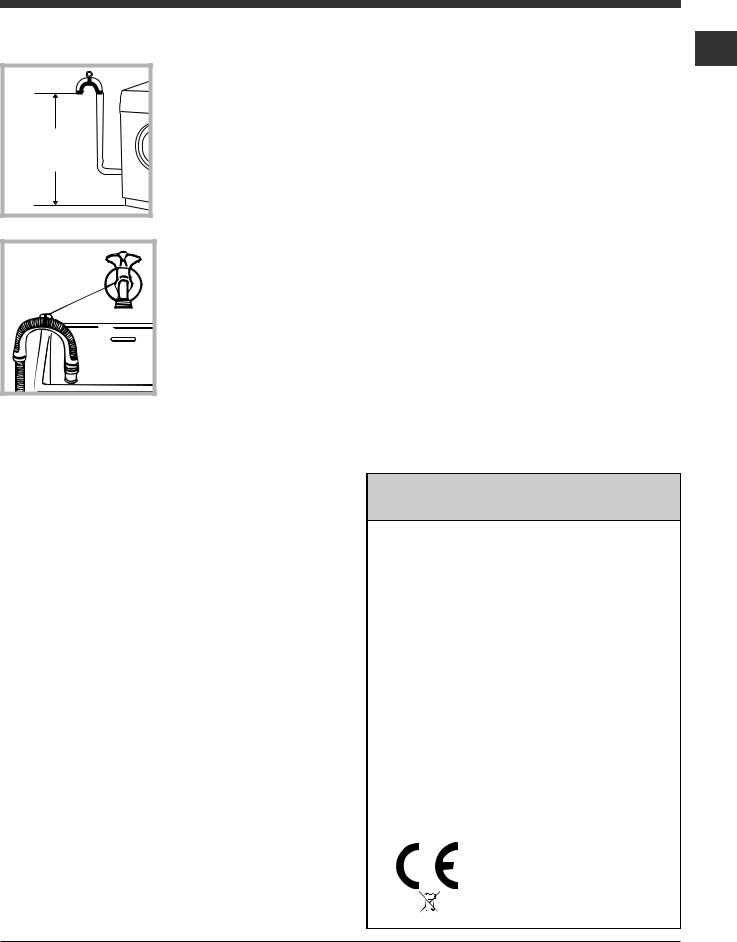
Connecting the drain hose
65 - 100 cm |
Connect the drain hose, without bending it, to a drainage duct or a wall drain located at a height between 65 and 100 cm from the floor;
alternatively, rest it on the side of a washbasin or bathtub, fastening the duct supplied to the tap (see figure). The free end of the hose should not be underwater.
We advise against the use of hose extensions; if it is absolutely necessary, the extension must have the same diameter as the original hose and must not exceed 150 cm in length.
Electrical connections
Before plugging the appliance into the electricity socket, make sure that:
•the socket is earthed and complies with all applicable laws;
•the socket is able to withstand the maximum power load of the appliance as indicated in the Technical data table (see opposite);
•the power supply voltage falls within the values indicated in the Technical data table (see opposite);
•the socket is compatible with the plug of the washing machine. If this is not the case, replace the socket or the plug.
The washing machine must not be installed outdoors, even in covered areas. It is extremely dangerous to leave the appliance exposed to rain, storms and other weather conditions.
When the washing machine has been installed, the electricity socket must be within easy reach.
Do not use extension cords or multiple sockets.
GB
The cable should not be bent or compressed.
The power supply cable must only be replaced by authorised technicians.
Warning! The company shall not be held responsible in the event that these regulations are not respected.
The first wash cycle
Once the appliance has been installed, and before you use it for the first time, run a wash cycle with detergent and no laundry, using the wash cycle 2.
Technical data
Model |
ECOSF 109 |
|||
|
|
|
|
|
|
|
|
width 59.5 cm |
|
Dimensions |
height 85 cm |
|||
|
|
|
depth 40 cm |
|
|
|
|
|
|
Capacity |
from 1 to 5 kg |
|||
|
|
|
|
|
Electrical |
please refer to the technical data |
|||
connections |
plate fixed to the machine |
|||
|
|
|
|
|
|
|
|
maximum pressure 1 MPa (10 bar) |
|
Water connections |
minimum pressure 0.05 MPa (0.5 bar) |
|||
|
|
|
drum capacity 40 litres |
|
|
|
|
|
|
Spin speed |
up to 1000 rotations per minute |
|||
|
|
|
|
|
Energy rated |
|
|||
programmes |
programme 6; temperature 60°C; |
|||
according to |
||||
using a load of 5 kg. |
||||
regulation |
||||
|
||||
EN 60456 |
|
|||
|
|
|
|
|
|
|
|
This appliance conforms to the |
|
|
|
|
following EC Directives: |
|
|
|
|
- 2004/108/EC (Electromagnetic |
|
|
|
|
Compatibility) |
|
|
|
|
- 2006/95/EC (Low Voltage) |
|
|
|
|
- 2002/96/EC |
|
|
|
|
||
3

Description of the washing machine and starting a wash cycle
Control panel
GB
|
|
|
WASH CYCLE PROGRESS |
|
|
|||||||||
|
|
|
|
|
|
indicator lights |
|
|
||||||
|
|
|
DISPLAY |
|
|
|
|
|
|
|
|
|||
ON/OFF |
|
TEMPERATURE |
|
|
|
|
|
|
|
|
|
|
DOOR |
|
|
|
|
|
|
|
|
|
|
|
|||||
button with indicator |
|
|
|
|
|
|
|
|
|
LOCKED |
||||
|
|
button |
|
|
|
|
|
|
|
|
|
|
||
light |
|
|
|
|
|
|
|
|
|
|
|
|
|
indicator light |
|
|
|
|
|
|
|
|
|
|
|
|
|
|
|
|
|
|
|
|
|
|
|
|
|
|
|
|
|
|
|
|
|
|
|
|
|
|
|
|
|
|
|
|
|
|
|
|
|
|
|
|
|
|
|
|
|
|
|
|
|
|
|
|
|
|
|
|
|
|
|
|
|
|
|
|
|
|
|
|
|
|
|
|
|
|
|
|
|
|
|
|
|
|
|
|
|
|
|
|
|
|
|
|
|
|
|
|
|
|
|
|
|
|
|
|
|
|
|
|
|
|
|
|
|
|
|
|
|
|
|
|
|
|
|
|
|
|
|
|
|
|
|
|
|
|
|
|
|
|
|
|
|
|
|
|
|
|
|
|
|
|
|
|
|
|
|
|
|
|
|
|
|
|
|
|
|
|
|
|
|
|
|
|
|
|
|
START/PAUSE |
|
|
|
|
|
|
|
|
|
Detergent dispenser drawer |
|
|
|
|
||
|
SPIN SPEED |
FUNCTION |
button with indicator |
||||
|
|
|
|||||
|
|
|
light |
||||
|
|
|
|
button |
buttons with |
||
|
|
|
|
|
|||
|
|
WASH CYCLE |
indicator lights |
|
|||
|
|
|
|
|
|||
|
|
knob |
|
|
|
||
|
|
|
CONTROL PANEL LOCK |
|
|||
|
|
|
button with indicator light |
|
|||
Detergent dispenser drawer: used to dispense detergents and washing additives (see “Detergents and laundry”).
There is a key which provides a summary of the available wash cycles inside the detergent dispenser drawer; this may be consulted at any time.
ON/OFF button with indicator light: switches the machine on and off.
If the indicator light is illuminated, this indicates that the machine is switched on.
WASH CYCLE knob: programmes the wash cycles. During the wash cycle, the knob does not move.
SPIN SPEED button: sets the spin speed or exclude the spin cycle completely (see “Personalisation”).
TEMPERATURE button: sets the temperature or the cold wash cycle (see “Personalisation”).
DISPLAY: indicates the time remaining for the selected wash cycle and, if a delayed start has been programmed, the time remaining until the start of the wash cycle.
CONTROL PANEL LOCK button with indicator light: activates or deactivates the control panel lock.
FUNCTION buttons with indicator light: used to select the available functions. The indicator light corresponding to the selected function will remain lit.
WASH CYCLE PROGRESS indicator lights: used to monitor the progress of the wash cycle.
The illuminated indicator light shows which phase is in progress.
DOOR LOCKED indicator light: indicates whether the door may be opened or not (see next page).
START/PAUSE button with indicator light: starts or temporarily interrupts the wash cycles.
N.B. To pause the wash cycle in progress, press this button; the corresponding indicator light will flash orange, while the indicator light for the current wash cycle phase will remain lit in a fixed manner. If the DOOR LOCKED  indicator light is switched off, the door may be opened.
indicator light is switched off, the door may be opened.
To start the wash cycle from the point at which it was interrupted, press this button again.
Standby mode
This washing machine, in compliance with new energy saving regulations, is fitted with an automatic standby system which is enabled after about 30 minutes if no activity is detected. Press the ON-OFF button briefly and wait for the machine to start up again.
4
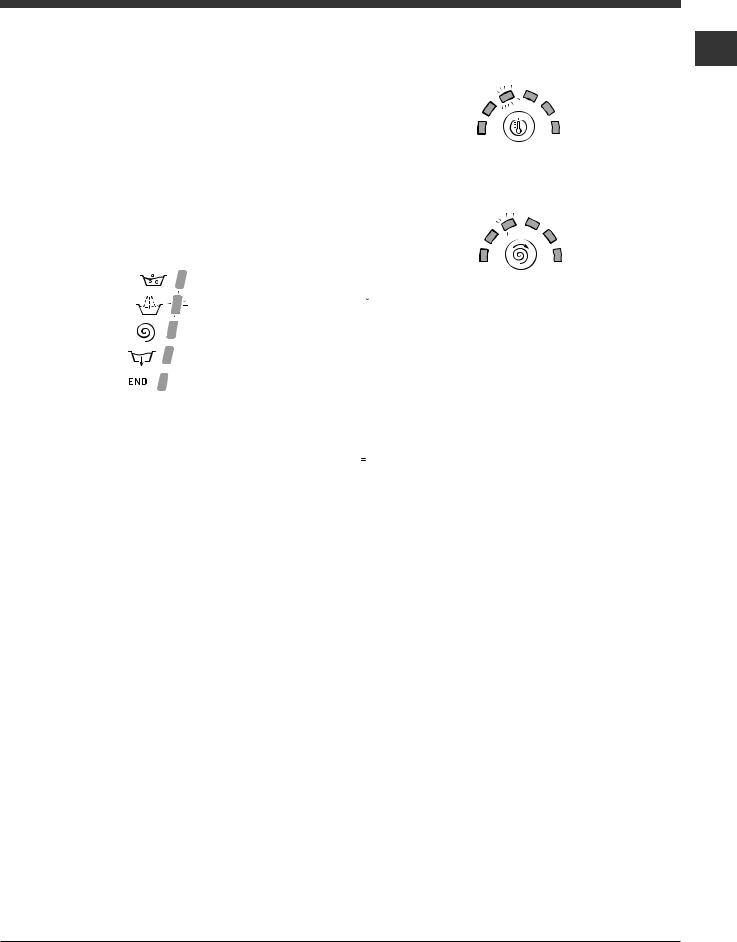
Indicator lights
The indicator lights provide important information. This is what they can tell you:
Wash cycle phase indicator lights
As the WASH CYCLE knob is rotated, the indicator lights illuminate, indicating the stages which will be performed by the machine in accordance with the selected wash cycle.
Once the desired wash cycle has been selected and has begun, the indicator lights switch on one by one to indicate which phase of the cycle is currently in progress.
Wash
Rinse
Spin
Drain no spin
End of wash cycle
Function buttons and corresponding indicator lights
When a function is selected, the corresponding indicator light will illuminate.
If the selected function is not compatible with the programmed wash cycle, the corresponding indicator light will flash, a sound signal will be emitted and the function will not be activated.
If a function which is incompatible with another function selected previously, only the most recent selection will remain active.
Temperature indicator light
When a temperature value is selected, the GB corresponding indicator light will illuminate.
Spin indicator light
When a spin value is selected, the corresponding indicator light will illuminate.
 Control panel lock indicator light
Control panel lock indicator light
To activate the control panel lock, press and hold the button for approximately 2 seconds. When the indicator light is illuminated, the control panel is locked. This means it is possible to prevent wash cycles from being modified accidentally, especially where there are children in the home.
To deactivate the control panel lock, press and hold the button for approximately 2 seconds.
 Door locked indicator light
Door locked indicator light
If this indicator light is on, the appliance door is locked to prevent it from being opened accidentally; to avoid any damage, wait for the indicator light to switch off before you open the appliance door.
N.B. If the DELAY TIMER function is activated, the door cannot be opened; pause the machine by pressing the START/PAUSE button if you wish to open it.
If the START/PAUSE indicator light (orange) flashes rapidly at the same time as the function indicator light, this indicates a problem has occurred (see “Troubleshooting”).
Starting a wash cycle
1.Turn the washing machine on by pressing the ON/OFF button. All the indicator lights will turn on for a few seconds, then only the indicator lights relative to the selected programme settings will remain lit and the START/ PAUSE indicator light will flash.
2.Load the laundry and close the door.
3.Set the WASH CYCLE knob to the desired programme.
4.Set the washing temperature (see “Personalisation”).
5.Set the spin speed (see “Personalisation”).
6.Measure out the detergent and washing additives (see “Detergents and laundry”).
7.Select the desired functions.
8.Start the wash cycle by pressing the START/PAUSE button and the corresponding indicator light will remain lit in a fixed manner, in green.
To cancel the set wash cycle, pause the machine by pressing the START/PAUSE button and select a new cycle.
9. At the end of the wash cycle the 
 indicator light will switch on. The DOOR LOCKED indicator light will switch off, indicating that the door may be opened. Take out your laundry and leave the appliance door ajar to make sure the drum dries completely. Switch the washing machine off by pressing the ON/OFF button.
indicator light will switch on. The DOOR LOCKED indicator light will switch off, indicating that the door may be opened. Take out your laundry and leave the appliance door ajar to make sure the drum dries completely. Switch the washing machine off by pressing the ON/OFF button.
5

Wash cycles
Table of wash cycles
GB |
|
|
|
|
|
|
|
|
|
|
|
|
cycles |
|
Max. |
Max. |
|
Detergents |
|
Max. |
Cycle |
||
|
|
|
|
|
|||||||
|
|
|
|
|
|
||||||
|
|
|
|
|
|
|
|
||||
|
|
|
Description of the wash cycle |
temp. |
speed |
|
|
|
|
load |
|
|
|
Wash |
Prew- |
Ble- |
|
Fabric |
duration |
||||
|
|
|
(°C) |
(rpm) |
Wash |
(kg) |
|
||||
|
|
|
|
|
|||||||
|
|
|
|
|
|
ash |
ach |
softener |
|
|
|
|
|
|
|
|
|
|
|
|
|
|
|
|
|
|
Daily |
|
|
|
|
|
|
|
|
|
1 |
Cotton + Prewash: extremely soiled whites. |
90° |
1000 |
• |
- |
• |
• |
5 |
|
|
|
|
|
|
|
|
|
|
|
|
|
|
|
2 |
Cotton: heavily soiled whites and resistant colours. |
60° |
1000 |
- |
• |
• |
• |
5 |
|
|
|
|
|
|
|
|
|
|
|
|
|
The |
|
|
2 |
Cotton (2): heavily soiled whites and delicate colours. |
40° |
1000 |
- |
• |
• |
• |
5 |
|
|
|
||||||||||
|
|
|
|
|
|
|
|
|
|
duration |
|
|
3 |
Coloured cottons (3): lightly soiled whites and delicate colours. |
40° |
1000 |
- |
• |
• |
• |
5 |
||
|
|
|
|
|
|
|
|
|
|
||
|
4 |
Synthetics: lightly soiled resistant colours. |
40° |
800 |
- |
- |
• |
• |
2,5 |
||
|
4 |
Synthetics: heavily soiled resistant colours. |
60° |
800 |
- |
- |
• |
• |
2,5 |
|
|
|
|
|
|
|
|
|
|
|
|
|
of |
|
|
5 |
Mix 15’: to refresh lightly soiled garments quickly (not suitable for wool, |
30° |
800 |
- |
- |
• |
• |
1,5 |
|
|
the |
||||||||||
|
|
|
silk and clothes which require washing by hand). |
|
|
|
|
|
|
|
|
|
|
|
|
|
|
|
|
|
|
|
|
|
|
|
Special |
|
|
|
|
|
|
|
wash |
|
|
6 |
Sanitizing cycle: extremely soiled whites. |
90° |
1000 |
- |
• |
• |
• |
5 |
|
|
|
||||||||||
|
|
|
|
|
|
|
|
|
|
cycles |
|
|
6 |
Sanitizing cycle (1): heavily soiled whites and resistant colours. |
60° |
1000 |
- |
- |
• |
• |
5 |
||
|
|
|
|
|
|
|
|
|
|
|
|
|
|
7 |
Goodnight cycle: lightly soiled delicate colours. |
40° |
800 |
- |
- |
• |
• |
3 |
|
|
|
||||||||||
|
8 |
Shirts |
40° |
600 |
- |
- |
• |
• |
2 |
can |
|
|
|
9 |
Silk/Curtains: for garments in silk and viscose, lingerie. |
30° |
0 |
- |
- |
• |
• |
1 |
|
|
be |
||||||||||
|
|
|
|
|
|
|
|
|
|
|
|
|
|
10 |
Wool: for wool, cashmere, etc. |
40° |
600 |
- |
- |
• |
• |
1 |
|
|
|
checked |
|||||||||
|
|
|
|
|
|
|
|
|
|
|
|
|
|
|
Eco cycle |
Water |
|
|
|
|
|
|
|
|
|
11 |
Cottons |
Cold |
1000 |
- |
- |
• |
• |
5 |
|
|
|
|
|
||||||||
|
|
|
|
|
|
|
|
|
|
|
on |
|
|
12 |
Synthetics |
Cold |
800 |
- |
- |
• |
• |
3 |
|
|
|
Water |
|||||||||
|
|
|
|
|
|
|
|
|
|
the |
|
|
|
13 |
Fast Wash |
Cold |
800 |
- |
- |
• |
• |
3 |
|
|
|
Water |
.display |
||||||||
|
|
|
|
|
|
|
|
|
|
||
|
|
A |
Rinse |
- |
1000 |
- |
- |
- |
• |
5 |
|
|
|
|
Partials wash cycles |
|
|
|
|
|
|
|
|
|
|
|
|
|
|
|
|
|
|
|
|
|
|
B |
Spin |
- |
1000 |
- |
- |
- |
- |
5 |
|
|
|
|
|
|
|
|
|
|
|
|
|
|
|
C |
Drain no Spin |
- |
0 |
- |
- |
- |
- |
5 |
|
|
|
|
|
|
|
|
|
|
|
|
|
The information contained in the table is intended as a guide only.
For all Test Institutes:
1)Test wash cycle in compliance with regulation EN 60456: set wash cycle 6 with a temperature of 60°C.
2)Long wash cycle for cottons: set wash cycle 2 with a temperature of 40°C.
3)Short wash cycle for cottons: set wash cycle 3 with a temperature of 40°C.
Specials wash cycles
Mix 15’(wash cycle 5) this wash cycle was designed to wash lightly soiled garments quickly: it lasts just 15 minutes and therefore saves both energy and time. By selecting this wash cycle (5 at 30°C), it is possible to wash different fabrics together (except for wool and silk items), with a maximum load of 1.5 kg.
Sanitizing cycle (wash cycle 6). A high-temperature hygienic wash cycle (over 60°C) which requires the use of bleach. Pour the bleach, the detergent and the additives into the relevant compartments (see paragraph entitled
“Detergent dispenser drawer”).
Goodnigt cycle (wash cycle 7). This is a silent cycle which can be run at night, when the electricity prices are lower. The wash cycle is designed for cottons and synthetics. At the end of the cycle the machine stops while there is still water in the drum; to spin and drain the laundry press the START/PAUSE button; alternatively the machine will perform the spin cycle and drain the water automatically after 8 hours.
Eco cycles
The Eco Cycles assure energy saving by eliminating the need of heating water and it’s an advantage both to your energy bill and the environment! These innovative Eco programmes (Cotton  , Synthetics
, Synthetics 
 and Fast Wash
and Fast Wash  ) are available for various fabrics and different quantity of garment; they have been designed to guarantee a high cleaning action even at low temperature and can be used for lightly to medium soiled loads.
) are available for various fabrics and different quantity of garment; they have been designed to guarantee a high cleaning action even at low temperature and can be used for lightly to medium soiled loads.
Eco Cycles give the best results thanks to an intensified wash action, water optimization and are carried out in the same average time of a standard cycle.
For the best washing results with Eco Cycles we recommend the usage of a liquid detergent.
6

Personalisation
Setting the temperature
By pressing the TEMPERATURE button to set the wash temperature (see Table of wash cycles). |
GB |
|
|
The temperature may be lowered, or even set to a cold wash ( ). |
|
The washing machine will automatically prevent you from selecting a temperature which is higher than the |
|
maximum value set for each wash cycle. |
|
Setting the spin speed
By pressing the SPIN SPEED button to set the spin speed for the selected wash cycle.
The maximum spin speeds available for each wash cycle are as follows:
Wash cycles |
Maximum spin speed |
Cottons |
1000 rpm |
Synthetics |
800 rpm |
Wool |
600 rpm |
Silk |
drain only |
The spin speed may be lowered, or the spin cycle can be excluded altogether by selecting the symbol  . The washing machine will automatically prevent you from selecting a spin speed which is higher than the maximum speed set for each wash cycle.
. The washing machine will automatically prevent you from selecting a spin speed which is higher than the maximum speed set for each wash cycle.
Functions
The various wash functions available with this washing machine will help to achieve the desired results, every time. To activate the functions:
1.Press the button corresponding to the desired function;
2.the function is enabled when the corresponding indicator light is illuminated.
Note: If the indicator light flashes rapidly, this signals that this particular function may not be selected in conjunction with the selected wash cycle.
 Delay timer
Delay timer
To set a delayed start for the selected wash cycle, press the button repeatedly until the desired delay time is
displayed (this may be between 1 hour and 24 hours). |
|
To disable the function press the button until the text |
is displayed. |
N.B. Once you have pressed the START/PAUSE button, the delay time may only be decreased if you wish to modify it.
This option is enabled with all programmes.
 Super Wash
Super Wash
Because a greater quantity of water is used in the initial phase of the cycle, and because of the increased cycle duration, this function offers a high-performance wash.
This function may not be used in conjunction with wash cycles 5, 6, 9, 10, 11, 12, 13, A, B. C.
 Extra rinse
Extra rinse
By selecting this function, the efficiency of the rinse is increased and optimal detergent removal is guaranteed. It is particularly useful for sensitive skin.
This function may not be used in conjunction with wash cycles 5, 13, B. C.
 Easy iron
Easy iron
By selecting this function, the wash and spin cycles will be modified in order to reduce the formation of creases. At the end of the cycle the washing machine will perform slow rotations of the drum; the EASY IRON and START/ PAUSE indicator lights will flash (orange) and the 
 phase will remain lit in a fixed manner. To end the cycle, press the START/PAUSE button or the EASY IRON button.
phase will remain lit in a fixed manner. To end the cycle, press the START/PAUSE button or the EASY IRON button.
For the Silk wash cycle, the machine will end the cycle while the laundry is soaking, the EASY IRON and START/ PAUSE indicator lights will flash (orange) and the RINSE phase will remain lit in a fixed manner. To drain the water so that the laundry may be removed, press the START/PAUSE button or the EASY IRON button.
This function may not be used in conjunction with wash cycles 5, 6, 7, 10, 11, 12, 13, B. C.
7
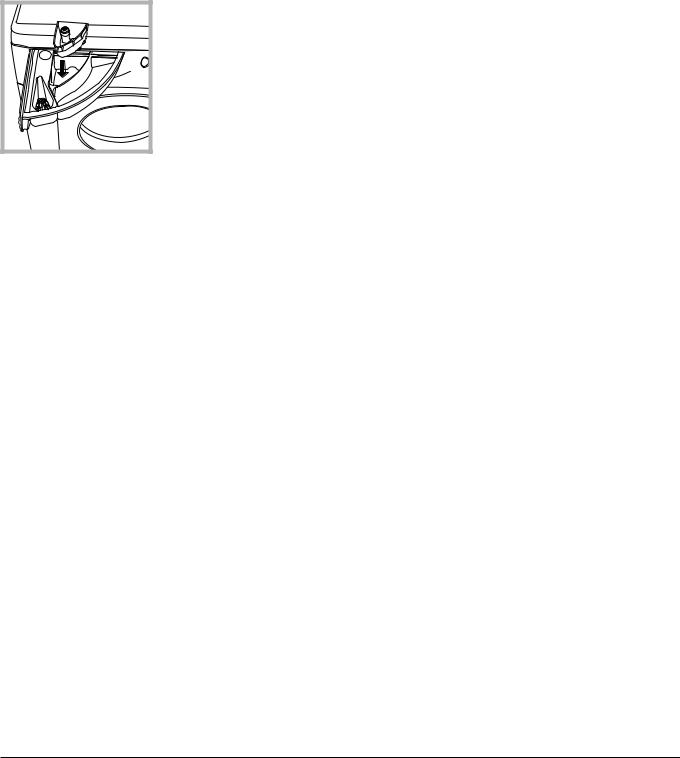
Detergents and laundry
|
|
|
|
|
|
Detergent dispenser drawer |
How much does your laundry weigh? |
||
|
||||
GB |
Good washing results also depend on the correct |
1 |
sheet 400-500 g |
|
|
||||
|
||||
|
dose of detergent: adding too much detergent will not |
1 pillow case 150-200 g |
||
|
necessarily result in a more efficient wash, and may in |
1 |
tablecloth 400-500 g |
|
|
fact cause build up on the inside of your appliance |
1 |
bathrobe 900-1200 g |
|
|
and contribute to environmental pollution. |
1 |
towel 150-250 g |
|
Do not use hand washing detergents because these create too much foam.
MAX |
4 |
|
1 |
3 |
2 |
|
Open the detergent dispenser drawer and pour in the detergent or washing additive, as follows.
compartment 1: Pre-wash detergent (powder)
Before pouring in the detergent, make sure that extra compartment 4 has been removed.
compartment 2: Detergent for the wash cycle (powder or liquid)
Liquid detergent should only be poured in immediately prior to the start of the wash cycle.
compartment 3: Additives (fabric softeners, etc.)
The fabric softener should not overflow the grid. extra compartment 4: Bleach
Bleach cycle
Bleaching may only be performed in conjunction with wash cycles 2, 3, 6.
Pour the bleach into extra compartment 4; pour the detergent and softener into the corresponding compartments, then select one of the abovementioned wash cycles.
This option is recommended only for very soiled cotton garments.
Preparing the laundry
•Divide the laundry according to:
-the type of fabric/the symbol on the label.
-the colours: separate coloured garments from whites
•Empty all garment pockets and check the buttons.
•Do not exceed the listed values, which refer to the weight of the laundry when dry:
Durable fabrics: max. 5 kg Synthetic fabrics: max. 2.5 kg Delicate fabrics: max. 2 kg Wool: max. 1 kg
Garments requiring special care
Shirts: use special wash cycle 8 to wash shirts in various fabrics and colours.
It guarantees maximum care is taken of the garments and minimises the formation of creases.
Silk: use special wash cycle 9 to wash all silk garments. We recommend the use of special detergent which has been designed to wash delicate clothes.
Curtains: fold curtains and place them in a pillow case or mesh bag. Use wash cycle 9.
Wool: is the only washing machine manufacturer to have been awarded the prestigious Woolmark Platinum Care endorsement (M.0508) by the Woolmark Company, which means that all woollen garments may be washed in the washing machine, even those which state “hand wash only”  on the label. Wash cycle 10 therefore offers complete peace of mind when washing woollen garments in the washing machine (max. load 1 kg) and guarantees optimal performance.
on the label. Wash cycle 10 therefore offers complete peace of mind when washing woollen garments in the washing machine (max. load 1 kg) and guarantees optimal performance.
Load balancing system
Before every spin cycle, to avoid excessive vibrations and to distribute the load in a uniform manner, the drum rotates continuously at a speed which is slightly greater than the washing rotation speed. If, after several attempts, the load is not balanced correctly, the machine spins at a reduced spin speed. If the load is excessively unbalanced, the washing machine performs the distribution process instead of spinning. To encourage improved load distribution and balance, we recommend small and large garments are mixed in the load.
8
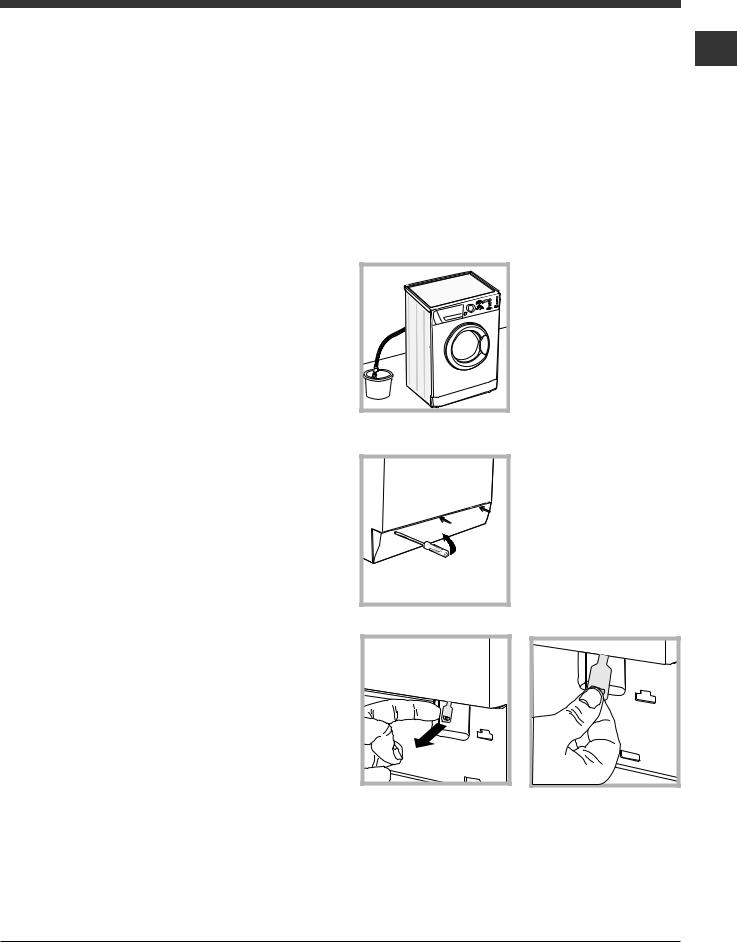
Precautions and tips
This washing machine was designed and constructed in accordance with international safety regulations. The following information is provided for safety reasons and must therefore be read carefully.
General safety
•This appliance is not intended for use by persons (including children) with reduced physical, sensory or mental capabilities, or lack of experience and knowledge, unless they have been given supervision or instruction concerning use of the appliance by a person responsible for their safety. Children should be supervised to ensure that they do not play with the appliance.
•This appliance was designed for domestic use only.
•Do not touch the machine when barefoot or with wet or damp hands or feet.
•Do not pull on the power supply cable when unplugging the appliance from the electricity socket. Hold the plug and pull.
•Do not open the detergent dispenser drawer while the machine is in operation.
•Do not touch the drained water as it may reach extremely high temperatures.
•Never force the porthole door. This could damage the safety lock mechanism designed to prevent accidental opening.
•If the appliance breaks down, do not under any circumstances access the internal mechanisms in an attempt to repair it yourself.
•Always keep children well away from the appliance while it is operating.
•The door can become quite hot during the wash cycle.
•If the appliance has to be moved, work in a group of two or three people and handle it with the utmost care. Never try to do this alone, because the appliance is very heavy.
•Before loading laundry into the washing machine, make sure the drum is empty.
Disposal
•Disposing of the packaging materials: observe local regulations so that the packaging may be re-used.
•The European Directive 2002/96/EC on Waste Electrical and Electronic Equipment, requires that old household electrical appliances must not be disposed of in the normal unsorted municipal waste stream. Old appliances must be collected separately in order to optimise the recovery and recycling of the materials they contain and reduce the impact on human health and the environment.
The crossed out "wheeled bin" symbol on the
product reminds you of your obligation, that when GB you dispose of the appliance it must be separately collected.
Consumers should contact their local authority or retailer for information concerning the correct disposal of their old appliance.
Opening the porthole door manually
In the event that it is not possible to open the porthole door due to a powercut, and if you wish to remove the laundry, proceed as follows:
1. remove the plug from the electrical socket.
2. make sure the water
level inside the machine is
 lower than the door 20
lower than the door 20 
 opening; if it is not, remove
opening; if it is not, remove
excess water using the drain hose, collecting it in a
bucket as indicated in the figure.
3. using a screwdriver, remove the cover panel on the lower front part of the washing machine (see figure).
4.pull outwards using the tab as indicated in the figure, until the plastic tie-rod is freed from its stop position; pull downwards and open the door at the same time.
5.reposition the panel, making sure the hooks are securely in place before you push it onto the
appliance.
9
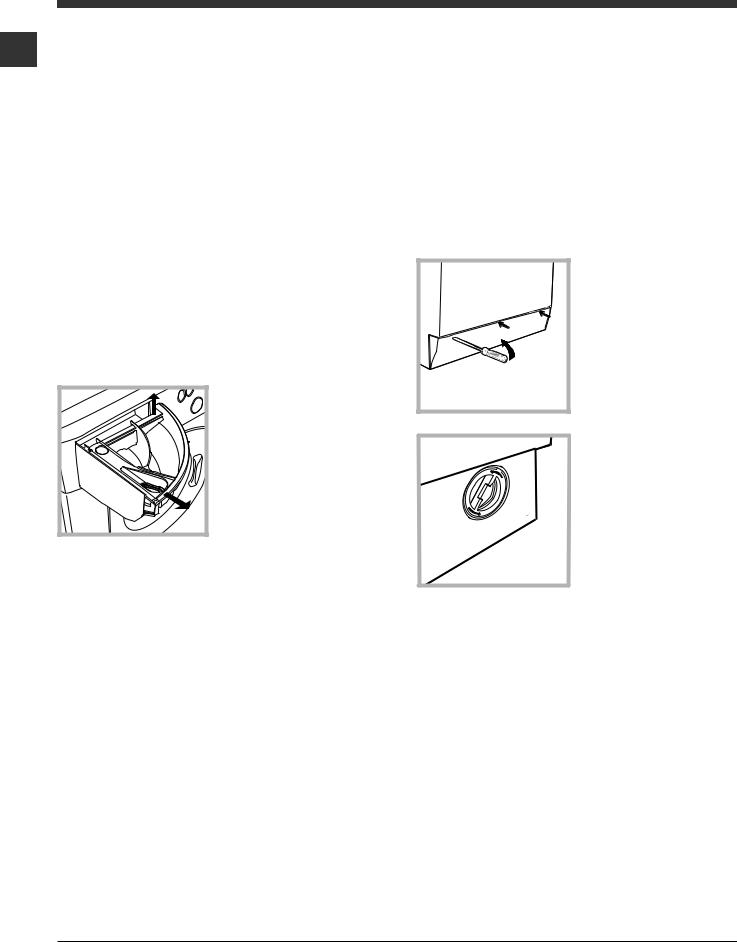
Care and maintenance
Cutting off the water and electricity GB supplies
•Turn off the water tap after every wash cycle. This will limit wear on the hydraulic system inside the washing machine and help to prevent leaks.
•Unplug the washing machine when cleaning it and during all maintenance work.
Cleaning the washing machine
The outer parts and rubber components of the appliance can be cleaned using a soft cloth soaked in lukewarm soapy water. Do not use solvents or abrasives.
Cleaning the detergent dispenser drawer
1 |
2 |
Remove the dispenser by raising it and pulling it out (see figure).
Wash it under running water; this operation should be repeated frequently.
Caring for the door and drum of your appliance
•Always leave the porthole door ajar in order to prevent unpleasant odours from forming.
Cleaning the pump
The washing machine is fitted with a self-cleaning pump which does not require any maintenance. Sometimes, small items (such as coins or buttons) may fall into the pre-chamber which protects the pump, situated in its bottom part.
Make sure the wash cycle has finished and unplug the appliance.
To access the pre-chamber:
1. using a screwdriver, remove the cover panel on the lower front part of the washing machine (see figure);
2. unscrew the lid by rotating it anti-clockwise (see figure): a little water may trickle out. This is perfectly normal;
3.clean the inside thoroughly;
4.screw the lid back on;
5.reposition the panel, making sure the hooks are securely in place before you push it onto the appliance.
Checking the water inlet hose
Check the inlet hose at least once a year. If there are any cracks, it should be replaced immediately: during the wash cycles, water pressure is very strong and a cracked hose could easily split open.
Never use second-hand hoses.
10

Troubleshooting
Your washing machine could fail to work. Before contacting the Technical Assistance Centre (see “Assistance”),
make sure that the problem cannot be not solved easily using the following list. |
GB |
|
|
||
Problem: |
Possible causes / Solutions: |
|
The washing machine does not switch on.
The wash cycle does not start.
•The appliance is not plugged into the socket fully, or is not making contact.
•There is no power in the house.
•The washing machine door is not closed properly.
•The ON/OFF button has not been pressed.
•The START/PAUSE button has not been pressed.
•The water tap has not been opened.
•A delayed start has been set (using the Delay Timer, see “Personalisation”).
The washing machine does not take in water (the indicator light for the first wash cycle stage flashes rapidly).
•The water inlet hose is not connected to the tap.
•The hose is bent.
•The water tap has not been opened.
•There is no water supply in the house.
•The pressure is too low.
•The START/PAUSE button has not been pressed.
The washing machine continuously takes in and drains water.
•The drain hose is not fitted at a height between 65 and 100 cm from the floor (see “Installation”).
•The free end of the hose is under water (see “Installation”).
•The wall drainage system is not fitted with a breather pipe.
If the problem persists even after these checks, turn off the water tap, switch the appliance off and contact the Assistance Service. If the dwelling is on one of the upper floors of a building, there may be problems relating to water drainage, causing the washing machine to fill with water and drain continuously. Special anti-draining valves are available in shops and help to avoid this inconvenience.
The washing machine does not drain or spin.
•The wash cycle does not include draining: some wash cycles require the drain phase to be started manually.
•The EASY IRON function has been activated: To complete the wash cycle, press the START/PAUSE button (“Personalisation”).
•The drain hose is bent (see “Installation”).
•The drainage duct is clogged.
The washing machine vibrates a • The drum was not unlocked correctly during installation (see “Installation”). lot during the spin cycle. • The washing machine is not level (see “Installation”).
• The washing machine is trapped between cabinets and walls (see “Installation”).
The washing machine leaks. • The water inlet hose is not screwed on properly (see “Installation”).
•The detergent dispenser drawer is blocked (for cleaning instructions, see “Care and maintenance”).
•The drain hose is not fixed properly (see “Installation”).
The START/PAUSE indicator light (orange) and the function indicator lights flash rapidly.
There is too much foam.
•Switch off the machine and unplug it, wait for approximately 1 minute and then switch it back on again.
If the problem persists, contact the Technical Assistance Service.
•The detergent is not suitable for machine washing (it should display the text “for washing machines” or “hand and machine wash”, or the like).
•Too much detergent was used.
11

Service
Before calling for Assistance:
GB |
• Check whether you can solve the problem alone (see “Troubleshooting”); |
|
|
|
• Restart the programme to check whether the problem has been solved; |
|
• If this is not the case, contact an authorised Technical Assistance Centre using the telephone number |
|
provided on the guarantee certificate. |
|
Always request the assistance of authorised technicians. |
Have the following information to hand:
•the type of problem;
•the appliance model (Mod.);
•the serial number (S/N).
This information can be found on the data plate applied to the rear of the washing machine, and can also be found on the front of the appliance by opening the door.
12

Návod k použití
|
|
PRAÈKA |
||
|
|
|
|
|
|
|
|
|
|
|
|
Obsah |
|
|
|
|
CZ |
||
|
|
|
|
|
|
|
Instalace, 14-15 |
|
|
CZ |
|
|
||
|
Rozbalení a vyrovnání do vodorovné polohy |
|||
|
|
Pøipojení k elektrické a k vodovodní síti |
||
|
|
|||
Èesky |
První prací cyklus |
|||
|
|
Technické údaje |
||
ECOSF 109
Popis praèky a zahájení pracího programu, 16-17
Ovládací panel Kontrolky
Zahájení pracího programu
Prací programy, 18
Tabulka pracích programù
Uživatelská nastavení, 19
Nastavení teploty
Nastavení rychlosti odstøeïování
Funkce
Prací prostøedky a prádlo, 20
Dávkovaè pracích prostøedkù
Cyklus bìlení
Pøíprava prádla
Odìvy vyžadující zvláštní péèi
Systém automatického vyvážení náplnì
Opatøení a rady, 21
Základní bezpeènostní pokyny
Likvidace
Manuální otevøení dvíøek
Údržba a péèe, 22
Uzavøení pøívodu vody a vypnutí elektrického napájení Èištìní praèky
Èištìní dávkovaèe pracích prostøedkù Péèe o dvíøka a buben
Èištìní èerpadla
Kontrola pøítokové hadice na vodu
Poruchy a zpùsob jejich odstranìní, 23
Servisní služba, 24
13
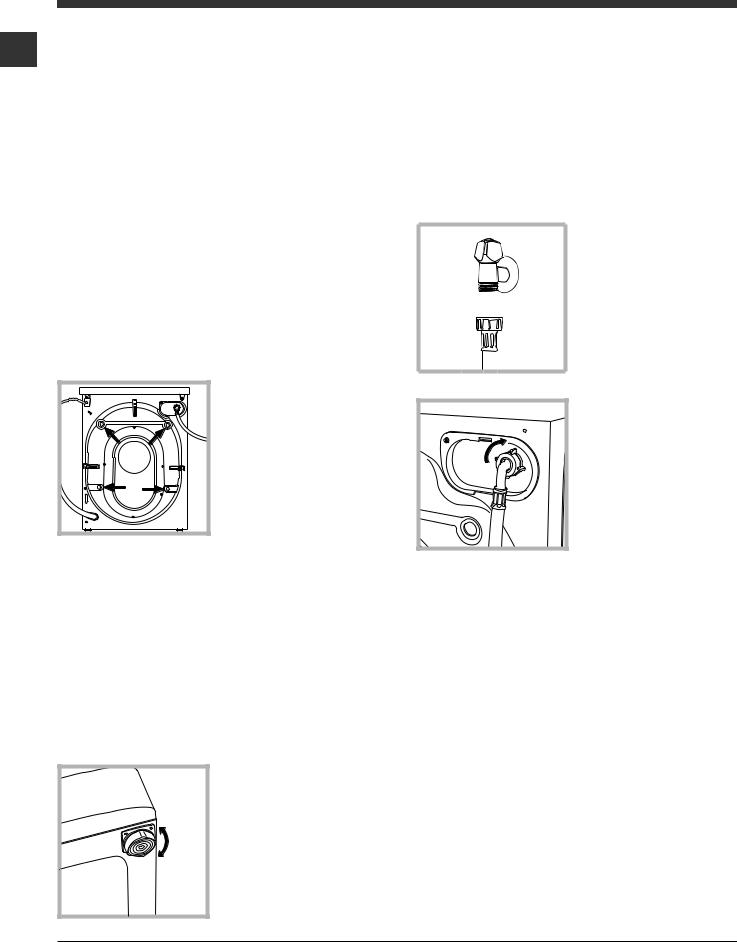
Instalace
Je dùležité uschovat tento návod tak, abyste jej CZ mohli kdykoli konzultovat. V pøípadì prodeje,
darování nebo pøestìhování praèky se ujistìte, že zùstane uložen v blízkosti praèky, aby mohl posloužit novému majiteli pøi seznámení s její èinností a s pøíslušnými upozornìními.
Pozornì si pøeètìte uvedené pokyny: obsahují dùležité informace týkající se instalace, použití a bezpeènosti pøi práci.
Rozbalení a vyrovnání do vodorovné polohy
Rozbalení
1.Rozbalte praèku.
2.Zkontrolujte, zda bìhem pøepravy nedošlo k jejímu poškození. V pøípadì, že je poškozena, ji nezapojujte a obra•te se na prodejce.
3. Odstraòte 4 šrouby chránící pøed poškozením bìhem pøepravy a gumovou podložku s pøíslušnou rozpìrkou, které se nacházejí v zadní èásti (viz obrázek).
4.Uzavøete otvory po šroubech plastovými krytkami z pøíslušenství.
5.Uschovejte všechny díly: v pøípadì opìtovné pøepravy praèky je bude tøeba namontovat zpìt.
Obaly nejsou hraèky pro dìti!
Vyrovnání do vodorovné polohy
1. Praèku je tøeba umístit na rovnou a pevnou podlahu, aniž by se opírala o stìnu, nábytek èi nìco jiného.
2. V pøípadì, že podlaha není dokonale vodorovná, mohou být pøípadné rozdíly vykompenzovány šroubováním pøedních nožek (viz obrázek);
Úhel sklonu, namìøený na pracovní ploše, nesmí pøesáhnout 2°.
Dokonalé vyrovnání do vodorovné polohy zabezpeèí stabilitu zaøízení a zamezí vzniku vibrací a hluku bìhem èinnosti. V pøípadì instalace na podlahovou krytinu nebo na koberec nastavte nožky tak, aby pod praèkou zùstal dostateèný volný prostor pro ventilaci.
Pøipojení k elektrické a k vodovodní síti
Pøipojení pøítokové hadice vody
1. Pøipojte pøívodní hadici jejím zašroubováním ke kohoutku studené vody s hrdlem se závitem 3/4“ (viz obrázek).
Pøed pøipojením hadice nechte vodu odtékat, dokud nebude èirá.
2. Pøipojte pøítokovou hadici k praèce prostøednictvím pøíslušné pøípojky na vodu, umístìné vpravo nahoøe
(viz obrázek).
3. Dbejte na to, aby hadice nebyla pøíliš ohnutá ani stlaèená.
Tlak v rozvodu vody se musí pohybovat v rozmezí hodnot uvedených v tabulce s technickými údaji
(viz vedlejší strana).
V pøípadì, že délka pøítokové hadice nebude dostateèná, obra•te se na specializovanou prodejnu nebo na autorizovaný technický personál.
Nikdy nepoužívejte již použité hadice.
Používejte hadice z pøíslušenství zaøízení.
14
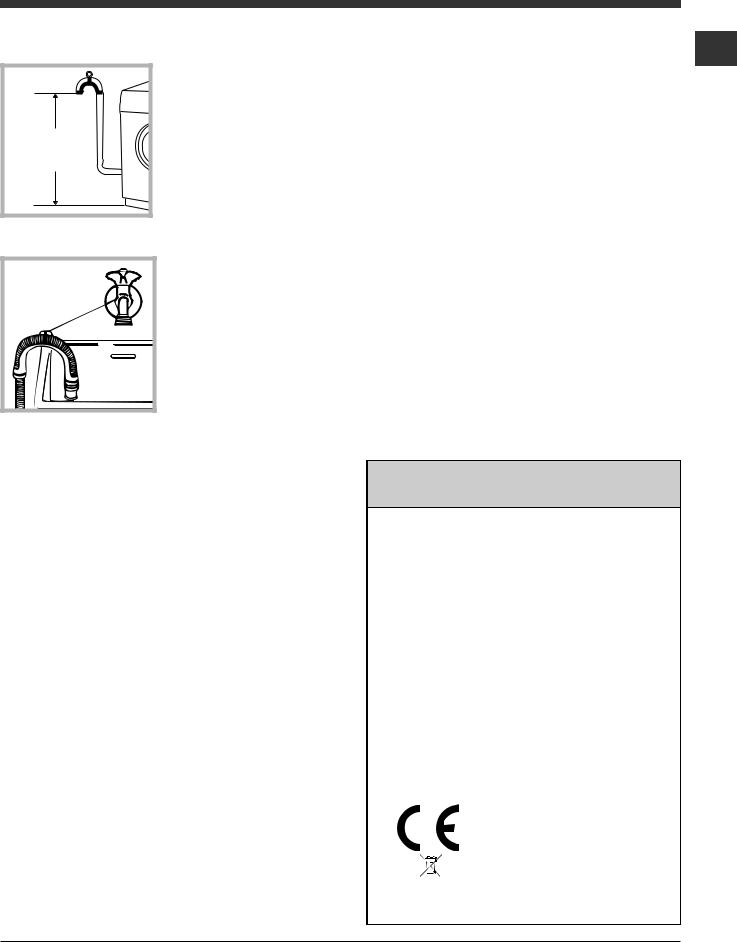
Pøipojení vypouštìcí hadice |
65 - 100 cm |
Pøipojte vypouštìcí hadici, aniž byste ji ohýbali, k odpadovému potrubí nebo k odpadu ve stìnì, který se nachází od 65 do 100 cm nad zemí;
nebo ji uchy•te k okraji umývadla èi vany a pøipevnìte vodicí držák z pøíslušenství ke kohoutu (viz obrázek). Volný konec vypouštìcí hadice nesmí zùstat ponoøený do vody.
Nepoužívejte prodlužovací kabely a rozvodky.
CZ
Kabel nesmí být ohnutý ani stlaèený.
Výmìna kabelu musí být svìøena výhradnì autorizovanému technickému personálu.
Upozornìní! Výrobce neponese žádnou odpovìdnost za následky nerespektování uvedených pøedpisù.
První prací cyklus
Po instalaci zaøízení je tøeba ještì pøedtím, než je použijete na praní prádla, provést jeden zkušební cyklus s pracím prostøedkem a bez náplnì prádla nastavením pracího programu 2.
Použití prodlužovacích hadic se nedoporuèuje; je-li však nezbytné, prodlužovací hadice musí mít stejný prùmìr jako originální hadice a její délka nesmí pøesáhnout 150 cm.
Pøipojení k elektrické síti
Pøed zasunutím zástrèky do zásuvky se ujistìte, že:
•Je zásuvka uzemnìna a že vyhovuje normám;
•je zásuvka schopna snést maximální zátìž odpovídající jmenovitému pøíkonu zaøízení, uvedenému v tabulce s technickými údaji
(viz vedle);
•hodnota napájecího napìtí odpovídá údajùm uvedeným v tabulce s technickými údaji (viz vedle);
•je zásuvka kompatibilní se zástrèkou praèky. V opaèném pøípadì je tøeba vymìnit zásuvku nebo zástrèku.
Praèka nesmí být umístìna venku – pod širým nebem, a to ani v pøípadì, že by se jednalo o místo chránìné pøed nepøízní poèasí, protože je velmi nebezpeèné vystavit ji pùsobení deštì a bouøí.
Po definitivní instalaci praèky musí zásuvka zùstat snadno pøístupná.
Technické údaje
Model |
ECOSF 109 |
|||
|
|
|
|
|
|
|
|
šíøka 59,5 cm |
|
Rozmìry |
výška 85 cm |
|||
|
|
|
hloubka 40 cm |
|
|
|
|
|
|
Kapacita |
od 1 do 5 kg |
|||
|
|
|
|
|
Napájení |
viz štítek s technickými údaji, |
|||
aplikovaný na zaøízení |
||||
|
|
|
||
|
|
|
|
|
Pøipojení k |
maximální tlak 1 MPa (10 bar) |
|||
minimální tlak 0.05 MPa (0.5 bar) |
||||
rozvodu vody |
||||
kapacita bubnu 40 litrù |
||||
|
|
|
||
|
|
|
|
|
Rychlost |
az¡ do 1000 otáèek za minutu |
|||
odstøeïování |
||||
|
||||
|
|
|
|
|
Kontrolní program |
program 6; teplota 60°C; |
|||
podle normy |
||||
náplò 5 kg prádla. |
||||
EN 60456 |
||||
|
||||
|
|
|
|
|
|
|
|
Toto zaøízení odpovídá následujícím |
|
|
|
|
normám Evropské unie: |
|
|
|
|
- 2004/108/CE (Elektromagnetická |
|
|
|
|
kompatibilita) |
|
|
|
|
- 2006/95/CE (Nízké napìtí) |
|
|
|
|
- 2002/96/CE |
|
|
|
|
||
|
|
|
|
|
Hluènost |
Praní: 54 |
|||
(dB(A) re 1 pW) |
Odstøeïování: 72 |
|||
15
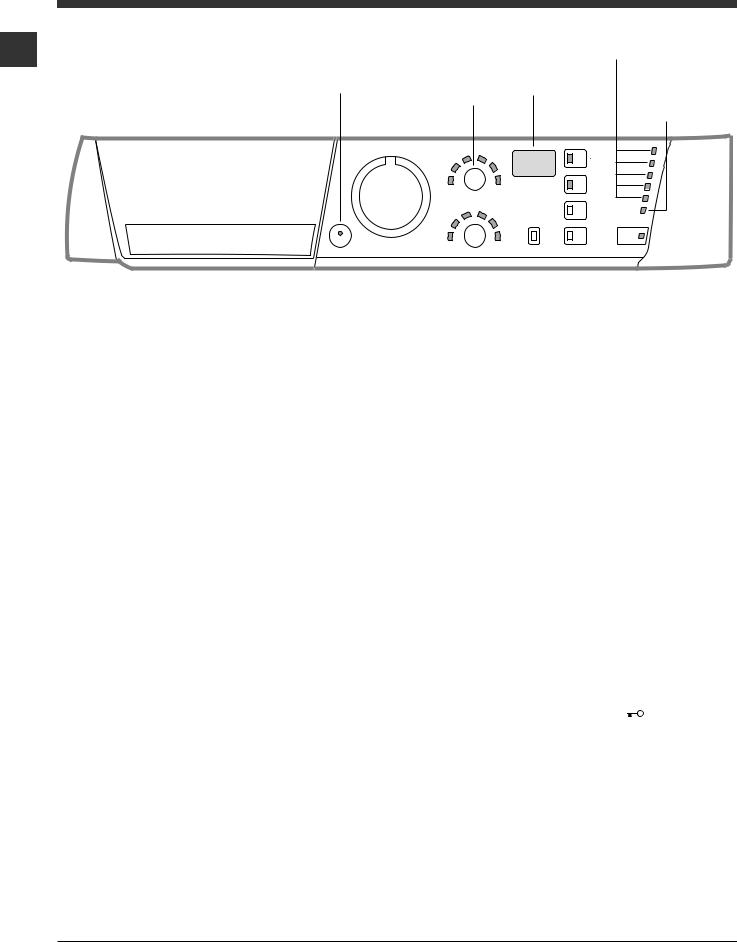
Popis praèky a zahájení pracího programu
Ovládací panel
CZ
|
Kontrolky |
|
|
|
PRÙBÌHU PRACÍHO CYKLU |
||
Tlaèítka s kontrolkami |
DISPLEJ |
Kontrolka |
|
|
ZABLOKOVANÁ |
||
ZAPNUTÍ/ |
Tlaèítko |
||
DVÍØKA |
|||
VYPNUTÍ |
|||
TEPLOTY |
|
||
|
|
|
|
|
|
|
|
|
Tlaèítko s |
|
|
|
|
|
|
|
|
|
|
|
|
|
|
|
|
|
|
|
|
|
|
|
|
|
|
|
|
|
|
|
|
|
|
|
|
|
|
|
|
|
Dávkovaè pracích |
|
|
|
|
|
|
|
|
|
|
Tlaèítko |
FUNKÈNÍ |
kontrolkou |
|||||
|
prostøedkù |
|
START/PAUZA |
||||||
|
|
ODSTØEÏOVÁNÍ |
tlaèítka s |
||||||
|
|
|
|
||||||
|
|
Otoèný ovladaè |
kontrolkami |
|
|||||
|
|
|
|
|
|
|
|||
|
|
PROGRAMÙ |
|
|
|
|
|
||
|
|
|
|
|
|
|
|||
|
|
|
|
Tlaèítka s |
|
||||
|
|
|
|
kontrolkami |
|
||||
|
|
|
|
ZABLOKOVÁNÍ |
|
||||
|
|
|
|
TLAÈÍTEK |
|
||||
Dávkovaè pracích prostøedkù: slouží k dávkování pracích prostøedkù a pøídavných prostøedkù (viz „Prací prostøedky a prádlo“).
Uvnitø dávkovaèe pracích prostøedkù je umístìn funkèní popis, jehož prostøednictvím je možné kdykoli konzultovat struèný pøehled pracích programù.
Tlaèítko a kontrolka ZAPNUTÍ/VYPNUTÍ: jeho stisknutí slouží k zapnutí a vypnutí zaøízení. Rozsvícená kontrolka informuje o zapnutí zaøízení.
Otoèný ovladaè PROGRAMÙ: pro nastavení pracích programù. Bìhem pracího programu zùstane ve stejné poloze.
Tlaèítko ODSTØEÏOVÁNÍ: slouží k nastavení odstøeïování nebo k jeho vylouèení (viz „Uživatelská nastavení“).
Tlaèítko TEPLOTY: slouží k nastavení teploty praní nebo praní ve studené vodì (viz „Uživatelská nastavení“).
DISPLEJ: slouží k zobrazování zbývající doby zvoleného pracího cyklu a v prípade nastavení odloženého startu k zobrazování doby, která zbývá do zahájení praní.
Tlaèítko a kontrolka ZABLOKOVÁNÍ TLAÈÍTEK: slouží k aktivaci nebo ke zrušení zablokování ovládacího panelu.
FUNKÈNÍ tlaèítka s kontrolkami: slouží k volbì jednotlivých dostupných funkcí. Kontrolka zvolené funkce zùstane rozsvícena.
Kontrolky PRÙBÌHU PRACÍHO CYKLU: slouží ke kontrole prùbìhu pracího programu.
Rozsvícená kontrolka poukazuje na probíhající fázi.
Kontrolka ZABLOKOVANÁ DVÍØKA: informuje o tom, zda je možné otevøít dvíøka (viz vedlejší strana).
Tlaèítko s kontrolkou START/PAUZA: Slouží
ke spuštìní nebo doèasnému pøerušení programù. POZN.: Stisknutí tohoto tlaèítka slouží k pøerušení probíhajícího praní; pøíslušná kontrolka bude blikat oranžovým svìtlem, zatímco kontrolka probíhající fáze zùstane rozsvícena stálým svìtlem. Když bude
kontrolka ZABLOKOVANÁ DVÍØKA |
zhasnuta, |
bude možné otevøít dvíøka. |
|
Za úèelem opìtovného zahájení praní z bodu, ve kterém bylo pøerušeno, znovu stisknìte toto tlaèítko.
Pohotovostní režim
Za úèelem shody s novými pøedpisy souvisejícími s energetickou úsporou je tato praèka vybavena systémem automatického vypnutí (pøechodu do pohotovostního režimu – standby), který je aktivován po uplynutí 30 minut, když se praèka nepoužívá. Krátce stisknìte tlaèítko ON/OFF a vyèkejte na obnovení èinnosti zaøízení.
16
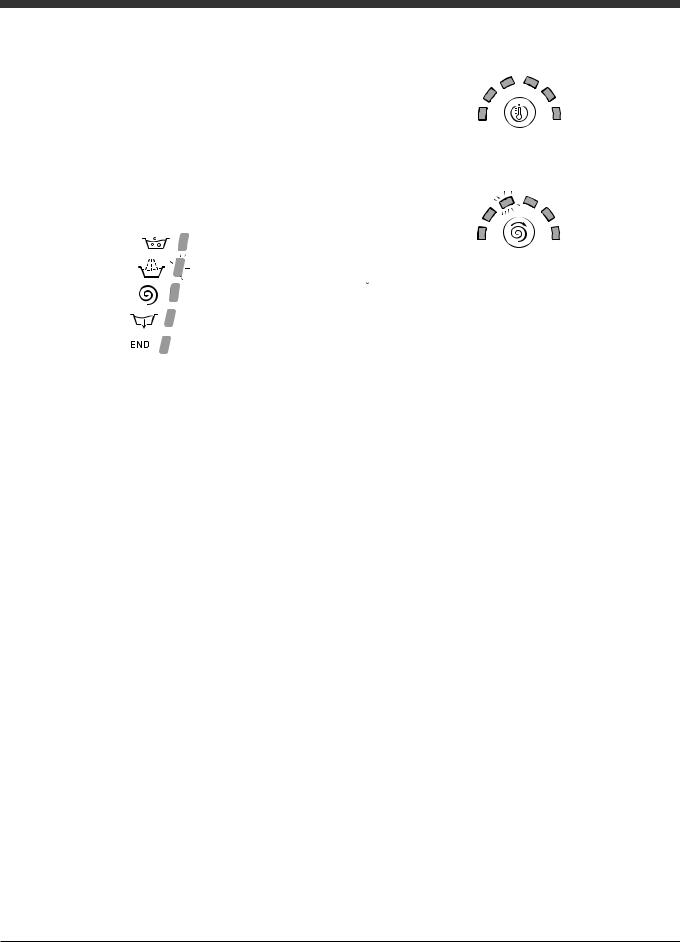
Kontrolky
Kontrolky jsou zdrojem dùležitých informací. Informují nás o následujících skuteènostech:
Kontrolka aktuální fáze pracího programu
Otáèením otoèného ovladaèe PROGRAMÙ se rozsvítí kontrolky oznaèující fáze, které zaøízení provede na základì zvoleného programu.
Po zvolení a zahájení požadovaného pracího cyklu dojde k postupnému rozsvícení kontrolek informujících o jeho prùbìhu.
Praní
Máchání
Odstøeïování
Odèerpání vody
Ukonèení praní
Funkèní tlaèítka a pøíslušné kontrolky
Po zvolení konkrétní funkce dojde k rozsvícení pøíslušné kontrolky.
Když zvolená funkce není kompatibilní s nastaveným programem, pøíslušná kontrolka bude blikat, bude vydán akustický signál a funkce nebude aktivována. V pøípadì, že bude zvolena funkce, která není kompatibilní s nìkterou z pøedem zvolených funkcí, zùstane aktivována pouze poslední zvolená funkce.
Kontrolka teploty |
CZ |
|
Pøi volbì libovolné hodnoty teploty dojde k rozsvícení |
||
|
||
kontrolky. |
|
|
|
Kontrolka odstøeïování
Pøi volbì libovolné hodnoty odstøeïování dojde k rozsvícení kontrolky.
 Kontrolka zablokování tlaèítek
Kontrolka zablokování tlaèítek
"Aktivace" zablokování ovládacího panelu se provádí tak, že podržíte stisknuté tlacítko približne na 2 sekundy. Rozsvícená kontrolka poukazuje na to, že je ovládací panel zablokován. Tímto zpusobem se zamezí náhodným zmenám programu, zejména když jsou v domácnosti deti.
"Zrušení" zablokování ovládacího panelu se provádí tak, že podržíte stisknuté tlacítko približne na 2 sekundy.
 Kontrolka zablokovaných dvíøek
Kontrolka zablokovaných dvíøek
Rozsvícení této kontrolky poukazuje na to, že dvíøka jsou zablokována kvùli zamezení náhodnému otevøení; aby se zabránilo poškození dvíøek, pøed jejich otevøením je tøeba vyèkat, dokud uvedená kontrolka nezhasne.
POZN.: když je aktivována funkce „Odloženého startu“, nebude možné otevøít dvíøka a pro jejich otevøení bude tøeba pøerušit èinnost zaøízení stisknutím tlaèítka START/PAUZA.
Rychlé blikání kontrolky START/PAUZA (oranžové) souèasnì s blikáním funkcí poukazuje na pøítomnost poruchy (viz „Poruchy a zpùsob jejich odstranìní“).
Zahájení pracího programu
1.Zapnìte praèku stisknutím tlaèítka ZAPNUTÍ/VYPNUTÍ. Všechny kontrolky se rozsvítí na nìkolik sekund a poté zùstanou svítit ty kontrolky, které se týkají nastavení zvoleného programu, a bude blikat kontrolka START/PAUZA.
2.Naplòte praèku a zavøete dvíøka.
3.Otoèným ovladaèem PROGRAMÙ nastavte požadovaný prací program.
4.Nastavte teplotu praní (viz „Uživatelská nastavení“).
5.Nastavte rychlost odstøeïování (viz „Uživatelská nastavení“).
6.Nadávkujte prací prostøedek a pøídavné prostøedky (viz „Prací prostøedky a prádlo“).
7.Zvolte požadované funkce.
8.Zahajte prací program stisknutím tlaèítka START/PAUZA a pøíslušná kontrolka zùstane rozsvícena stálým svìtlem zelené barvy. Zrušení nastaveného pracího cyklu se provádí pøerušením èinnosti zaøízení stisknutím tlaèítka START/ PATA a volbou nového cyklu.
9.Po ukonèení pracího programu se rozsvítí kontrolka 
 . Dojde ke zhasnutí kontrolky ZABLOKOVANÁ DVÍØKA s cílem informovat o možnosti otevøení dvíøek. Vytáhnìte prádlo a nechte dvíøka pootevøená, aby bylo umožnìno vysušení bubnu. Vypnìte praèku stisknutím tlaèítka ZAPNUTÍ/VYPNUTÍ.
. Dojde ke zhasnutí kontrolky ZABLOKOVANÁ DVÍØKA s cílem informovat o možnosti otevøení dvíøek. Vytáhnìte prádlo a nechte dvíøka pootevøená, aby bylo umožnìno vysušení bubnu. Vypnìte praèku stisknutím tlaèítka ZAPNUTÍ/VYPNUTÍ.
17
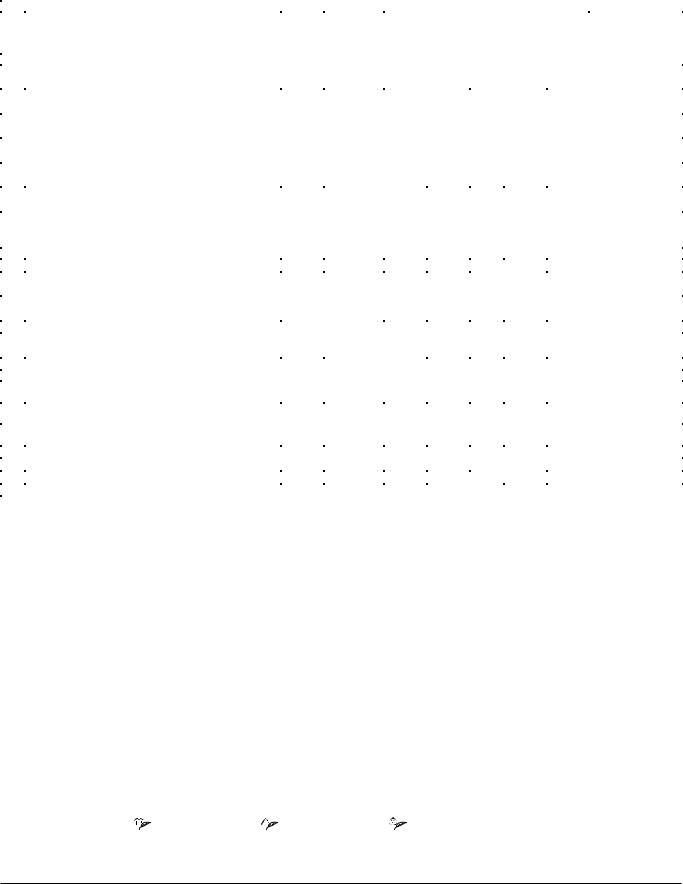
Prací programy
|
|
|
|
|
|
|
|
|
|
|
|
|
|
|
Tabulka pracích programù |
|
|
|
|
|
|
|
|
|
|
CZ |
|
|
|
|
|
|
|
|
|
|||
|
|
|
|
|
|
|
|
|
|
|
|
|
|
|
Programy |
|
Max. |
Max. |
|
Prací prostøedky |
|
|
Doba trvání cyklu |
|
|
|
|
|
|
|
|
|
||||||
|
|
|
teplota |
za minutu) |
írkou |
dek |
|
|
(kg) |
|
||
|
|
|
Popis programu |
(°C) |
(otáèky |
Pøedp |
prostøe |
Praní |
Aviváž |
náplò |
|
|
|
|
|
|
|
|
|
|
|
|
|
||
|
|
|
|
|
|
|
|
|
|
|
|
|
|
|
|
Speciální programy |
|
|
|
|
|
|
|
|
|
|
|
1 |
BAVLNA+PØEDPåRKOU: Mimoøádnì zneèištìné bílé |
90° |
1000 |
• |
- |
• |
• |
5 |
|
|
|
prádlo. |
|
|
|
|
|
|
|||||
|
|
|
|
|
|
|
|
|
|
|
|
|
|
|
2 |
BAVLNA: Silnì zneèištìné bílé a barevné prádlo |
60° |
1000 |
- |
• |
• |
• |
5 |
|
|
|
z odolných tkanin. |
|
|
|
|
Je |
|
|||||
|
|
|
|
|
|
|
|
|
|
|
||
|
|
2 |
BAVLNA (2): Silnì zneèištìné bílé a barevné |
40° |
1000 |
- |
• |
• |
• |
5 |
|
|
|
|
možné |
|
|||||||||
|
choulostivé prádlo. |
|
|
|
|
|
|
|||||
|
|
|
|
|
|
|
|
|
|
|
||
|
|
|
|
|
|
|
|
|
|
|
|
|
|
|
3 |
BAREVNÁ BAVLNA (3): Málo zneèištìné bílé a |
40° |
1000 |
- |
• |
• |
• |
5 |
|
|
|
barevné choulostivé prádlo. |
|
|
|
|
|
|
|
||||
|
|
|
|
|
|
|
|
|
|
kontrolovat |
|
|
|
|
4 |
SYNTETIKA: Velmi zneèištìné barevné prádlo |
60° |
800 |
- |
- |
• |
• |
2,5 |
|
|
|
|
|
|
|||||||||
|
z odolných tkanin. |
|
|
|
|
|
||||||
|
|
|
|
|
|
|
|
|
|
|
|
|
|
|
4 |
SYNTETIKA: Èásteènì zneèištìné barevné prádlo |
40° |
800 |
- |
- |
• |
• |
2,5 |
|
|
|
z odolných tkanin. |
|
|
|
|
|
||||||
|
|
|
|
|
|
|
|
|
|
|
|
|
|
|
|
MIX 15':K rychlému oživení mírnì zneèištìného prádla |
|
|
|
|
|
|
|
dobu |
|
|
|
5 |
(nedoporuèuje se pro vlnu, hedvábí a prádlo urèené pro |
30° |
800 |
- |
- |
• |
• |
1,5 |
|
|
|
|
|
||||||||||
|
|
|
ruèní praní). |
|
|
|
|
|
|
|
|
|
|
|
|
Programy pro každodenní praní |
|
|
|
|
|
|
|
trvání |
|
|
|
|
SANITARY (1): Silnì zneèištìné bílé a barevné prádlo |
90° |
1000 |
- |
• |
• |
• |
5 |
|
|
|
6 |
SANITARY: Mimoøádnì zneèištìné bílé prádlo. |
1000 |
• |
• |
|
|
|||||
|
|
6 |
z odolných tkanin. |
60° |
|
- |
- |
|
|
5 |
pracích |
|
|
|
|
|
|
|
|
|
|
|
|
||
|
|
|
|
|
|
|
|
|
|
|
|
|
|
|
7 |
DOBROU NOC: Èásteènì zneèištìné barevné |
40° |
800 |
- |
- |
• |
• |
3 |
|
|
|
choulostivé prádlo. |
|
|
|
|
|
||||||
|
|
|
|
|
|
|
|
|
|
|
|
|
|
|
8 |
KOŠILE |
40° |
600 |
- |
- |
• |
• |
2 |
programù |
|
|
|
9 |
HEDVÁBÍ/ZÁCLONY : Pro prádlo z hedvábí, viskózy, |
30° |
0 |
- |
- |
• |
• |
1 |
|
|
|
|
|
|
|||||||||
|
spodní prádlo. |
|
|
|
|
|||||||
|
|
|
|
|
|
|
|
|
|
|
|
|
|
|
10 |
VLNA: Pro vlnu, kašmír atd. |
40° |
600 |
- |
- |
• |
• |
1 |
|
|
|
|
|
Eko programy |
|
|
|
|
|
|
|
na |
|
|
|
11 |
BAVLNA |
studen |
1000 |
- |
- |
• |
• |
5 |
|
|
|
á voda |
|
|
.displeji |
|
|||||||
|
|
|
|
|
|
|
|
|
|
|
||
|
|
|
|
studen |
|
|
|
• |
• |
|
|
|
|
|
12 |
SYNTETICKÉ PRÁDLO |
studen |
800 |
- |
- |
• |
• |
3 |
|
|
|
á voda |
|
|
|
|
|||||||
|
|
|
|
|
|
|
|
|
|
|
|
|
|
|
13 |
RYCHLÉ PRANÍ 30’ |
á voda |
800 |
- |
- |
|
|
3 |
|
|
|
|
|
|
|
|
|
|
|
|
|
|
|
|
|
|
Dílèí programy |
|
|
|
|
|
|
|
|
|
|
|
A |
Máchání |
- |
1000 |
- |
- |
- |
• |
5 |
|
|
|
|
B |
Odstøeïování |
- |
1000 |
- |
- |
- |
- |
5 |
|
|
|
|
C |
Odèerpání vody |
- |
0 |
- |
- |
- |
- |
5 |
|
|
Údaje uvedené v tabulce mají pouze informativní charakter.
Pro všechny Kontrolní ústavy:
1)Kontrolní program podle normy EN 60456: nastavte program 6 s teplotou 60°C.
2)Dlouhý program na praní bavlny: nastavte program 2 s teplotou 40°C.
3)Krátký program na praní bavlny: nastavte program 3 s teplotou 40°C.
Speciální programy
Mix 15' (program 5) byl navržen pro praní mírnì zneèištìného prádla bìhem krátké doby: trvá pouze 15 minut a šetøí tak energii a èas. Nastavením programu (5 pøi 30°C) je možné prát spoleènì prádlo z tkanin rùzného druhu (s výjimkou vlny a hedvábí) s maximální náplní 1,5 kg.
Sanitary (program 6). Hygienizaèní program pøi vysokých teplotách, u kterého se používá bìlicí prostøedek pøi teplotì vyšší než 60°C. Pøi bìlení nalijte bìlicí prostøedek, prací prostøedky a pøídavné prostøedky do pøíslušných pøihrádek (viz odstavec „Dávkovaè pracích prostøedkù“).
Dobrou noc (program 7). Jedná se o tichý cyklus, který mùže pracovat v noci, kdy platí snížená sazba za dodávku elektrické energie. Program byl navržen pro praní prádla ze syntetických tkanin a z bavlny. Na konci pracího cyklu se zaøízení zastaví s vodou v bubnu; za úèelem provedení odstøeïování a odèerpání vody stisknìte tlaèítko START/ PAUZA. V opaèném pøípadì zaøízení po uplynutí 8 hodin automaticky provede odstøedìní a odèerpání vody.
Eko programy
Programy Eko nabízejí dobrou výkonnost praní pøi nízkých teplotách, pøièemž umožòují nižší použití elektrické energie s výhodami pro životní prostøedí i pro finanèní úsporu.
Programy Eco (Bavlna , Syntetické prádlo |
|
a Rychlé praní 30’ ) byly vytvoøeny pro rùzné druhy tkanin a pro |
|
||
mírnì zneèištìné prádlo. |
|
|
Pro zajištìní optimálního výsledku doporuèujeme použít tekutý prací prostøedek; doporuèuje se pøedbìžnì ošetøit manžety, límce a skvrny.
18
